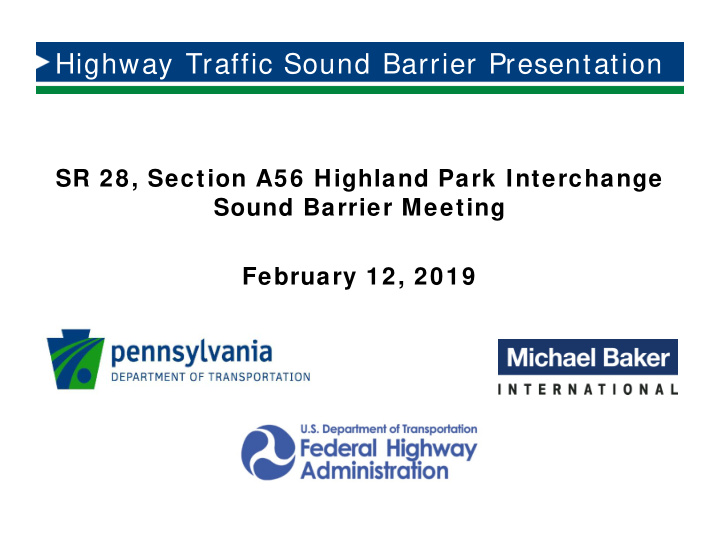



Highway Traffic Sound Barrier Presentation SR 28, Section A56 Highland Park Interchange Sound Barrier Meeting February 12, 2019
Project Team PennDOT District 11-0 Cheryl Moon-Sirianni, P.E. - District Executive Doug Seeley, P.E - Assistant District Executive, Design Division Erik Porter, P.E, - Senior Project Manager Mark Young - District Environmental Manager Nick Krobot, P.E. - Assistant Environmental Project Manager Michael Baker International John Tricini, P.E., PLS - Project Manager David Jackson, P.E. - Roadway Design Engineer Andy Kuchta - Noise Analysis Technical Manager Justin Miller – Public Involvement Specialist 2
Meeting Form at PRESENTATION • Mark Young, PennDOT District Environmental Manager – Welcome, Project Introduction and Meeting Purpose • Erik Porter, P.E., Project Manager, PennDOT – Overview of the Overall Project • Andrew Kuchta, Michael Baker International – Summary of Highway Sound Analysis Process – Location of the Proposed Sound Barriers – Sound Wall Considerations and Constraints – Available Community-side Barrier Styles and Colors – Opportunity to see the predicted sound level reductions at your benefited property 3
Purpose of this Meeting • Provide voting information to the benefited homeowners and residential renters in regards to having a sound barrier constructed (or not constructed) near their homes. • Provide voting information on the type, style and/or color of the proposed sound barriers on the community side if they wish to have PennDOT construct the barrier. 4
Project Overview Video 5
Noise Analysis Process - 1 PROJECT LIMITS 6
Noise Analysis Process - 2 • A Noise Analysis was conducted in 2017 and the project area was divided into FOUR Noise Sensitive Areas (NSAs) 7
Noise Analysis Process - 3 • Representative measurement sites were selected. o Field measurements were made to validate the model in each NSA. • Noise-sensitive analysis receptors were selected to include all residences, schools, parks, etc. • The FHWA-approved Traffic Noise Model (TNM) was used to predict the worst-case sound levels for the existing and future conditions at all noise-sensitive receptors. • Impacts were identified for noise-sensitive receptors where the modeled sound level equaled or exceeded 66 decibels (dBA) or if the proposed project caused an increase of 10 or more dBA over the existing condition. – (dBA) stands for decibels (dB) on the A-weighted (human) perception scale. 8
Noise Analysis Process - 4 Note: (dBA) stands for decibels (dB) on the A-weighted (human) perception scale. 9
Noise Analysis Process - 5 • Subsequently, noise abatement analysis is warranted for impacted sites based on Feasibility and Reasonableness. o Feasibility and Reasonableness primarily deal with: o Attaining noticeable sound level decreases: (≥ 5 dBA for the majority of the impacted sites with at least one site attaining a 7 dBA reduction). o Observing PennDOT construction regulations regarding drainage, trees, signs, utilities, safety, terrain, wetlands, right-of-way and maintenance. o Benefiting the majority of impacted sites (50+%) with a barrier that meets the ≤2,000 square foot per benefited receptor criteria. • Following the December 2017 Public Meeting, the sound wall dimensions were adjusted in length and height in various places based on public input. • The results determined that sound barriers were feasible and reasonable in two (2) locations east of the interchange. 10
Proposed Sound Barrier Locations • Noise Sensitive Area ( NSA) Barrier NSA 3 - SR 28 Northbound from the Aspinwall Recreational Area to the Lexington/Delafield Bridge Area. (4,680’ long, 6-11’ high with decibel reductions from 5-8 dBA, ~100 benefited sites) • Barrier NSA 4 - SR 28 Southbound from the Lexington/Delafield Bridge Area to the Western Avenue Area. (2,760’ long, 8.5-20’ high with decibel reductions from 5-17 dBA, 56 benefited sites) 11
Sound W all Considerations - 1 • The Owners and Renters of Benefited sites will vote on Noise Sensitive Area ( NSA) approving the sound barrier, its color and its texture. o “Benefited” is defined as a site receiving a ≥5 decibel (noticeable) sound level reduction. o This sound barrier meeting is being held to present/ discuss the barrier specifics with the Benefited owners/renters. o Reasonable efforts have already been made to contact people for voting purposes via certified mail and this meeting. o ≥50% of the counted votes must be in favor of the sound barrier in order to move forward in the Final Design phase. o “Impacted ” is defined when the modeled sound level is ≥ 66 dBA or if there is an increase of ≥10 dBA over the existing condition. 12
Sound W all Considerations - 2 Noise Sensitive Area ( NSA) o The barrier’s color and texture will then be counted from the received “Yes” votes. o The Benefited owners/renters will determine the residential-side texture and color. o PennDOT will determine the highway-side texture and color. • Final interpretation of the results will be made by PennDOT/consultants, considering all feedback gained during the public involvement process. 13
Sound Barrier Styles/ Colors - 1 • Grape Stake (Brown) • Grape Stake • Grape Stake (Grey) (Tan) 14
Sound Barrier Styles/ Colors - 2 • Irregular Stone (Gray) • Irregular Stone (Brown) • Irregular Stone (Tan) 15
Sound Barrier Styles/ Colors - 3 • Ashlar Stone (Brown) • Ashlar Stone (Gray) • Ashlar Stone (Tan) 16
Sound Barrier Styles/ Colors - 4 • Brick (Red) 17
Sound Barrier Styles/ Colors - 5 • Transparent / Grape Stake (Brown) • Transparent / Irregular Stone • Transparent / Ashlar Stone (Tan) 18
Sound Barrier Styles/ Colors - 6 Anti-Bird Threads will be incorporated into all transparent panels if transparent panels are selected by the benefited residents. 19
SR 28 SOUND BARRIER VOTING BALLOT
Project I nput / Feedback www.penndot.gov • Blue bar at the upper portion of the screen click on “Regional Offices” • Go to the map and click on • Right side column click on “Public Meetings” • Look for: “SR 28 Highland Park Interchange Reconstruction Project” 21
Project I nput / Feedback THANK YOU !! & Questions 22
Recommend
More recommend